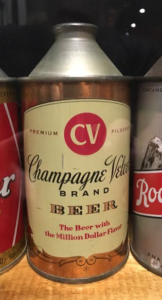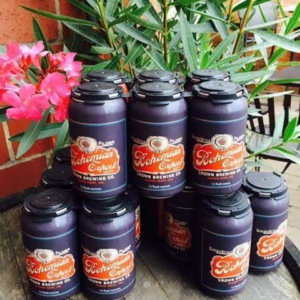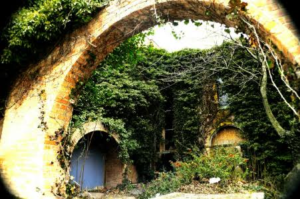 By Mark Lasbury for Indiana On Tap
By Mark Lasbury for Indiana On Tap
Indiana brewing history should be celebrated. Some do this by writing books, while others pay homage by visiting Indiana breweries and learning about their styles of beer (Walter and I fall into this category). But some brewers celebrate historic Indiana beers by bringing them back to life. Here we describe a few beers from 1800’s and early 1900’s Indiana that have been revived by craft brewers across the state. The styles include a couple of pilsners, an altbier, a schwarzbier, and a traditional lager – is it surprising that they are all German styles? No – 90% of the breweries in 1800’s Indiana were owned by Germans (Indiana: One Pint at a Time by Douglas Wissing).

Champagne Velvet from Upland Brewing
Why not begin with the most well-known example of Indiana beer resurrection. The Terre Haute Brewing Company (THBC) opened its doors in 1855 and brewmaster Walter Braun introduced Champagne Velvet (or CV as it is also known) in 1902. It soon became a very popular beer. At one point, THBC catapulted to the seventh largest brewery in the country based on the popularity of CV. As with so many others, THBC didn’t survive Prohibition and closed its doors for good in 1918 – or so it seemed.
New owners reopened THBC after Prohibition and tried to reintroduce CV; in fact, CV has been brought back to life several times in different forms. Launched in 1934 with much fanfare, CV became a mainstay of the brewery again. Unfortunately, despite high public praise and purchase, THBC closed in 1958 and CV was lost for a second time.
The brand was purchased by various breweries and CV was made in and out of the state and in an off and on fashion over the years, but none of these were based on the original recipe, they merely wanted to cash in on the name recognition of the original and follow up beers – one version was actually a malt liquor. After these attempts, CV was seemingly lost to time. That’s when an avid collector in Terre Haute named Mike Rowe (no, not that Mike Rowe) purchased a hand written notebook by Walter Braun containing most of the original CV recipe. He only paid twenty bucks to the worker who had found the heirloom, which means it was definitely an Antiques Roadshow talk-to-the-host type moment. The Upland website says that the recipe was once insured for one million dollars.
In 2000, Rowe opened a new THBC in the original building – the same building in which the recipe was found. His flagship beer was none other than CV, based on the original recipe but modernized for current day techniques. He even began bottling CV in 2003, but the success was short-lived. He closed the second coming of THBC in 2008 and leased the brewery to Brugge Brasserie in Indianapolis.
Upland Brewing in Bloomington stepped in and purchased the recipe and trademark rights from Rowe in 2012 as a special one off production for their upcoming fifteenth anniversary. They reworked Braun’s notes yet again and settled on a single recipe after 30 test batches were brewed. After the first couple of years, Upland switched to malt from Sugar Creek Malt Co. in Boone County because they had developed a pre-prohibition style malt – so CV is more traditional now than anytime since 1918!

‘Ol Tavern Lager from People’s Brewing Co.
German beers were all the rage in Indiana in the 1800’s, and they do pretty darn well now. But they aren’t all that lives under the Sun. An originally German lager has been reworked as an American lager with a full craft treatment. Coming out of Lafayette and more than 150 years old, ‘Ol Tavern Lager is once again an Indiana favorite.
By 1862, the Thieme and Wagner Brewery in Tippecanoe County was producing Tavern Brew beer. After a few ownership changes and the ravages of Prohibition, the company became Lafayette Brewery, Inc. This company made a post-prohibition beer called Ye Tavern that was in fact based on Thieme & Wagner’s Tavern Brew (or Ye Tavern Brew) recipe. Even the branding and labeling were similar to the pre-prohibition version. It was good while it lasted, but Lafayette closed in 1953.
The new Lafayette Brewing Company was formed in 1993 as the second brewpub in the state (Broad Ripple Brewpub was first in 1990). One of Lafayette’s early brewers, Chris Johnson, left in 2010 to open People’s Brewing across town. People’s has revived the Ye Tavern Lager using branding very similar to the original, just changing the name to ‘Ol Tavern Beer. Chris and those helping him with this project didn’t find the original recipe for Ye Tavern Brew, but they did find purchase orders that gave them a good indication as to the types of ingredients and amounts used in the beer they were brewing. Working backward from the receipts and orders, they reverse engineered the Ye Tavern beer and came up with a better than workable recipe that replicates the style and feel of the original beer.
People’s began serving ‘Ol Tavern Beer at the brewery in 2014, followed closely by canning the same beer with a retro-can look. Now ‘Ol Tavern can be found everywhere that People’s distributes and is a very popular beer. It’s nice to have a connection between the present on and the past, and ‘Ol Tavern provides that link to both a beer and a brewery. Once you know the connection, the beer tastes better and takes on a special meaning, especially for those who grew up in the Lafayette area.

William Tell Altbier from St. Benedict’s Brew Works
Indiana’s German brewing history (at one point in the 1800’s, 90% of Indiana breweries were German-owned) can easily be seen in Southern Indiana. Schnitz Brewery & Pub in Jasper and Tell City Beer Co. inside the Pour Haus in Tell City are fine examples, but the story to be related here comes from the St. Benedict’s Brew Works in Ferdinand. Not only is this a fine brewery in the German/Belgian monastic style, it is brewing a beer from 1800’s Indiana.
Co-owner Vince Luecke related the story about how, in the course of his job as newspaper editor for the Perry County News and the Spencer County Journal, he came across some old German writings. Cursory translations showed that some of the documents were beer recipes, and that meant that the hunt was on. The recipes likely came from the Tell City Brewing Company, which operated in that town from 1858 to 1918 under several names, but for a long period up to Prohibition under the Tell City Brewing name (Bob Ostrander in Hoosier Beer: Tapping Into Indiana Brewing History). There was also a Tell City Brewery establishment, but they produced much less beer and probably fewer styles than did Tell City Brewing Company.
Vince and co-owner Andy Hedinger speak some German so Vince translated the recipes in full, which wasn’t so easy. German beer traditions mandated that recipes took narrative form rather than list-type directions, usually with a description of a base beer and then additional paragraphs for specialty versions of that beer (Douglas Wissing’s book Indiana: One Pint At A Time). To make matters worse, Vince told me that once the recipes were translated, they had measurements like, “a handful” or “some” in them – not easy to transmute for modern brewing. Although not named as such, the ingredients and procedures indicated that one beer was an alt, an old beer. This refers to the old type of German brewing with top fermenting yeast, even after bottom-fermenting yeast became all the rage. The lagering process, with its cold conditioning over longer periods of time helped to mellow out the altbier’s hop bitterness and the fruitiness of the esters so that even an ale will obtain some lager-like qualities.
St. Benedict’s Brew Works sells the old alt recipe beer under the name William Tell Alt. Walter and I tried it on a recent visit to the brewery on the grounds of the Sisters of St. Benedict Monastery. It was a nice, malty beer with a medium hop presence and a dry finish. We liked it a lot as an excellent example of a probable North German Altbier, a bit darker and milder than a classic Dusseldorf Alt. At present, the William Tell is served only at the brewery and a couple of local restaurants, but St. Benedict’s is expanding their system soon and perhaps other parts of the state will have a chance to try this 150 year old Indiana beer.

Harmonie Bier Dark Lager from Great Crescent Brewery
Perhaps the oldest beer in the state is being made by Great Crescent Brewery in Aurora. The original beer was made on the opposite side of the state, in New Harmony, but it was found again in the late 2000’s by Douglas Wissing. He related the tale of the find and translation in his book, Indiana: On Pint At A Time, including how the old Harmonist German dialect had to be translated into modern German before it could converted to English. The schwarzbier recipe originally belonged to George Bentel, the cooper and brewery for the New Harmony utopian colony as early as 1816. As such, this was most likely the oldest brewing operation in the state.
Once the recipe was translated and adapted by German author Horst Dornbusch to use ingredients available today but approximating the original recipe, the Brewers of Indiana Guild agreed to use the recipe for a replicale competition (all entering brewers make a beer using the same exact recipe) in 2010. Several beers were entered, with one standing out to the brewers who made it. Brewmaster Dan Valas of Great Crescent told me that the people in the Great Crescent brew house just really enjoyed this beer and so did the customers – so they kept making it.
Dan said that that the beer became popular, so they rebranded it as the Harmonie Bier Dark Lager and began distribution. Sara’s Harmony Way, a restaurant in New Harmony now takes about half of the beer made each year. This makes the beer a success, but Great Crescent has gone further. They worked with the Indiana Artisan project. Thoroughly Indiana products, from foods to objet d’art, which reflect Hoosier craftsmanship and ingredients are tagged with the Indiana Artisan label. This is a great occurrence since 2016 is the 200th anniversary of this beer.

Bohemian Export from Crown Brewing
There is one case where the Indiana craft beer community revived both beers and brewery. Crown Point used to be home to one of the largest breweries in pre-prohibition Indiana. Crown Brewing started out as Julius Korn Brewing before the Civil War. It passed through several people hands and then was purchased by L. Sonneschein Company from Chicago in 1895. The re-incorporated the business under the name Crown Brewing and built a four story building on the site of the original brewery at Pratt and Goldsboro Streets, just a half mile from the current iteration of Crown Brewing (according to Bob Ostrander in Hoosier Beer: Tapping Into Indiana Brewing History).
The brewery remained in Crown Point until 1910 when they relocated to Hammond. The new Crown Brewing, opened in 2008 by Tim Walsh and Dave Bryan probably doesn’t have the same issue, even though they are located just a half-mile from the previous Crown Brewing. I talked to head brewer Steve Mazylewski about Crown’s efforts to bring back an old brand from the original Crown Brewing. He said that once Crown had been open for a couple of years, a patron came in carrying some original Crown Brewing labels that he had found in a desk or similar. They were for a beer called Bohemian Export. They knew from the labels that this was a Czech style pilsner, but they didn’t have the exact recipe. Basically nothing remains from the original brewery.
Steve and the other people at Crown decided to make a Czech style pilsner with German malts and Czech Saaz hops to revive this old brand of beer. They made a batch a couple of years ago and used the label that they had been brought (with minor digital adjustments). It sold so well that they made a bigger batch the next year and canned it for distribution. Bohemian Export has been such a success that they are brewing it yearly now in April or May for a summer distribution across northern Indiana. They have a second beer they have resurrected from the old Crown Brewing, Kronen Bräu Dortmunder Helles, so you need to get to the brewery and try both.

Other Indiana Breweries With Links To The Past
Other breweries in Indiana also reflect both the styles and names of previous Hoosier beer makers. New Boswell In Richmond is named for Ezra Boswell, the second professional brewer in Indiana. Summit City Brewerks in Fort Wayne is named in honor of the Phenning Brewery of that city that was renamed Summit City Brewery in 1868. Finally, Zorn Brew Works (1871-1938) in Michigan City will re-emerge in November, 2016 – in the same building as the original Zorn Brewery. Zorn personnel say that they will brewing some pre-prohibition style beers, thereby continuing the relationship of present Indiana craft beer and the rich brewing history of the state.
